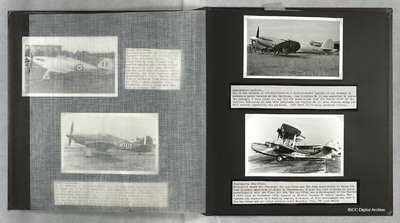Seafire and Sea Otter
Title
Seafire and Sea Otter
Description
Photo 1 is a port side ground view of a Seafire.
Photo 2 is a port side ground view of a Sea Otter biplane seaplane.
Photo 2 is a port side ground view of a Sea Otter biplane seaplane.
Coverage
Language
Type
Format
Two b/w photographs on an album page
Publisher
Rights
This content is available under a CC BY-NC 4.0 International license (Creative Commons Attribution-NonCommercial 4.0). It has been published ‘as is’ and may contain inaccuracies or culturally inappropriate references that do not necessarily reflect the official policy or position of the University of Lincoln or the International Bomber Command Centre. For more information, visit https://creativecommons.org/licenses/by-nc/4.0/ and https://ibccdigitalarchive.lincoln.ac.uk/omeka/legal.
Identifier
PThomasAF20080036
Transcription
[Photograph]
Supermarine Seafire.
Due to the success of the Hurricane as a carrier-borne fighter it was decided to produce a naval version of the Spitfire. One Spitfire Mk VB was converted to prove the concept, & this paved the way for 538 conversions with the Merlin 45/46 as the Seafire. Following on from this programme the Seafire Mk III with folding wings for full carrier capability was produced. 1250 Mark III’s being produced in total.
[Photograph]
Supermarine Sea Otter.
Originally names the Stingray, the Sea Otter had the twin distinction of being the last bi-plane amphibian produced by Supermarine, & also the last bi-plane to serve operationally with the Fleet Air Arm. The Sea Otter was a development of the Walrus & first flew in September 1938. Powered by Bristol Perseus V1 radial engine. The Pegasus was replaced by a Mercury engine, & because of this development was slow & the Sea Otter did not enter service until November 1944. 290 were built.
Supermarine Seafire.
Due to the success of the Hurricane as a carrier-borne fighter it was decided to produce a naval version of the Spitfire. One Spitfire Mk VB was converted to prove the concept, & this paved the way for 538 conversions with the Merlin 45/46 as the Seafire. Following on from this programme the Seafire Mk III with folding wings for full carrier capability was produced. 1250 Mark III’s being produced in total.
[Photograph]
Supermarine Sea Otter.
Originally names the Stingray, the Sea Otter had the twin distinction of being the last bi-plane amphibian produced by Supermarine, & also the last bi-plane to serve operationally with the Fleet Air Arm. The Sea Otter was a development of the Walrus & first flew in September 1938. Powered by Bristol Perseus V1 radial engine. The Pegasus was replaced by a Mercury engine, & because of this development was slow & the Sea Otter did not enter service until November 1944. 290 were built.
Collection
Citation
“Seafire and Sea Otter,” IBCC Digital Archive, accessed November 4, 2024, https://ibccdigitalarchive.lincoln.ac.uk/omeka/collections/document/23302.
Item Relations
This item has no relations.

